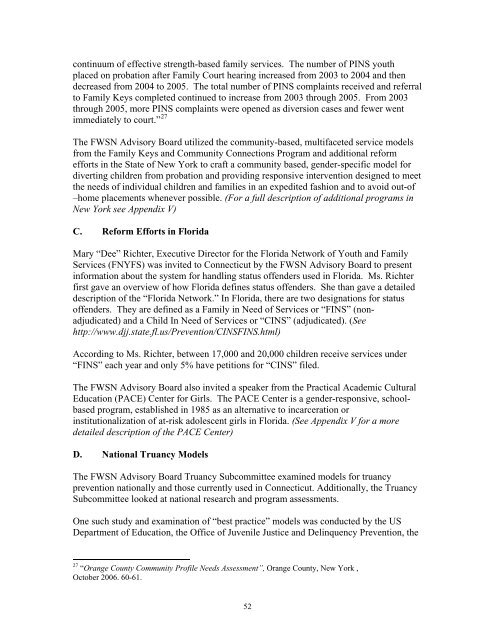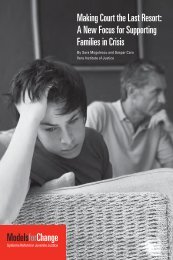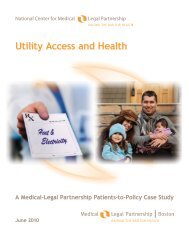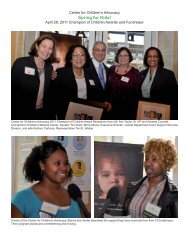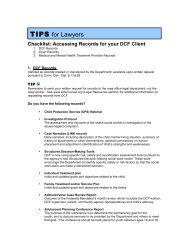FWSN-advisorybd-repo.. - The Connecticut Juvenile Justice Alliance
FWSN-advisorybd-repo.. - The Connecticut Juvenile Justice Alliance
FWSN-advisorybd-repo.. - The Connecticut Juvenile Justice Alliance
Create successful ePaper yourself
Turn your PDF publications into a flip-book with our unique Google optimized e-Paper software.
continuum of effective strength-based family services. <strong>The</strong> number of PINS youth<br />
placed on probation after Family Court hearing increased from 2003 to 2004 and then<br />
decreased from 2004 to 2005. <strong>The</strong> total number of PINS complaints received and referral<br />
to Family Keys completed continued to increase from 2003 through 2005. From 2003<br />
through 2005, more PINS complaints were opened as diversion cases and fewer went<br />
immediately to court.” 27<br />
<strong>The</strong> <strong>FWSN</strong> Advisory Board utilized the community-based, multifaceted service models<br />
from the Family Keys and Community Connections Program and additional reform<br />
efforts in the State of New York to craft a community based, gender-specific model for<br />
diverting children from probation and providing responsive intervention designed to meet<br />
the needs of individual children and families in an expedited fashion and to avoid out-of<br />
–home placements whenever possible. (For a full description of additional programs in<br />
New York see Appendix V)<br />
C. Reform Efforts in Florida<br />
Mary “Dee” Richter, Executive Director for the Florida Network of Youth and Family<br />
Services (FNYFS) was invited to <strong>Connecticut</strong> by the <strong>FWSN</strong> Advisory Board to present<br />
information about the system for handling status offenders used in Florida. Ms. Richter<br />
first gave an overview of how Florida defines status offenders. She than gave a detailed<br />
description of the “Florida Network.” In Florida, there are two designations for status<br />
offenders. <strong>The</strong>y are defined as a Family in Need of Services or “FINS” (nonadjudicated)<br />
and a Child In Need of Services or “CINS” (adjudicated). (See<br />
http://www.djj.state.fl.us/Prevention/CINSFINS.html)<br />
According to Ms. Richter, between 17,000 and 20,000 children receive services under<br />
“FINS” each year and only 5% have petitions for “CINS” filed.<br />
<strong>The</strong> <strong>FWSN</strong> Advisory Board also invited a speaker from the Practical Academic Cultural<br />
Education (PACE) Center for Girls. <strong>The</strong> PACE Center is a gender-responsive, schoolbased<br />
program, established in 1985 as an alternative to incarceration or<br />
institutionalization of at-risk adolescent girls in Florida. (See Appendix V for a more<br />
detailed description of the PACE Center)<br />
D. National Truancy Models<br />
<strong>The</strong> <strong>FWSN</strong> Advisory Board Truancy Subcommittee examined models for truancy<br />
prevention nationally and those currently used in <strong>Connecticut</strong>. Additionally, the Truancy<br />
Subcommittee looked at national research and program assessments.<br />
One such study and examination of “best practice” models was conducted by the US<br />
Department of Education, the Office of <strong>Juvenile</strong> <strong>Justice</strong> and Delinquency Prevention, the<br />
27 “Orange County Community Profile Needs Assessment”, Orange County, New York ,<br />
October 2006. 60-61.<br />
52


